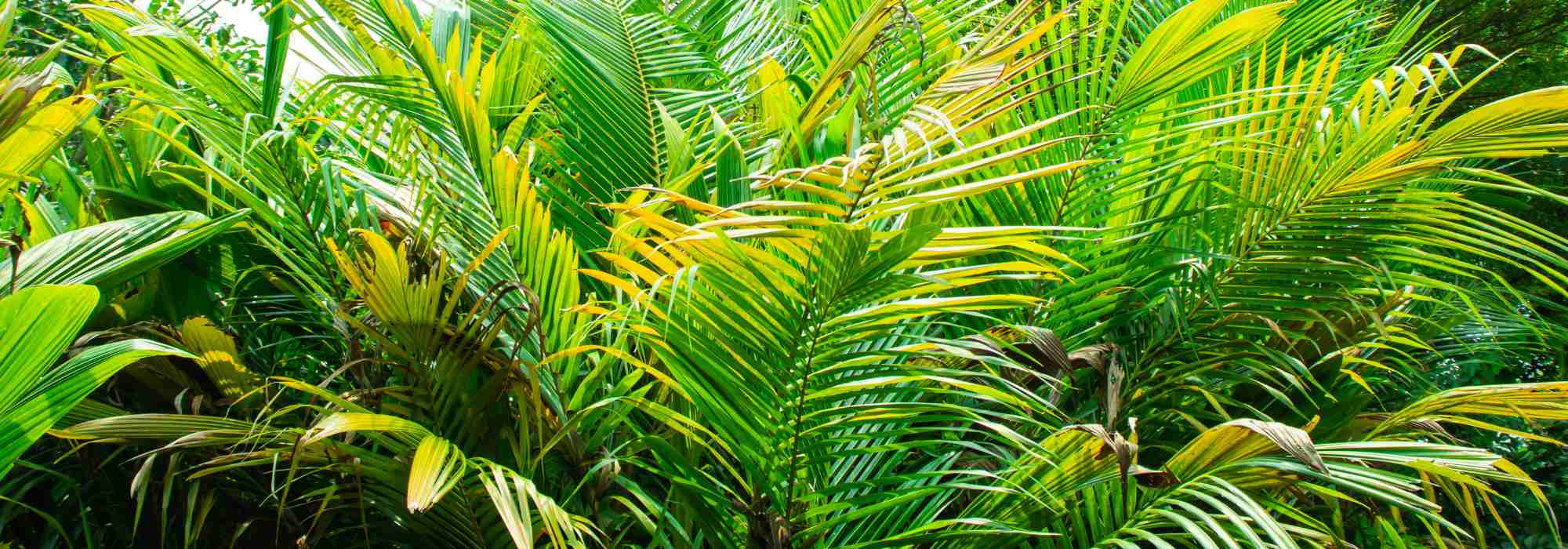
Dypsis - Areca palm: how to grow and care for it ?
Contents
Dypsis in a few words
- The Dypsis or Areca is an elegant tropical palm, native to Madagascar, perfect for indoor settings.
- It thrives in bright, indirect light, with moderate watering and a slightly humid environment.
- Its maintenance is easy, requiring repotting every 2-3 years and light fertilisation during the growth period.
- It pairs beautifully with terracotta, wicker, or concrete pots for a natural decorative touch.
The word from our expert
The Dypsis, a majestic palm from the Arecaceae family, captivates with its elegant foliage and tropical silhouette. Native to the humid forests of Madagascar, it adapts perfectly to indoor cultivation, where it adds an exotic and soothing touch. Among the most sought-after varieties is the famous Dypsis lutescens, sometimes called the Areca palm, Areca, or Butterfly palm, and the striking Dypsis decaryi, recognisable by its unique triangular trunk.
Easy to care for, the Dypsis thrives in bright but filtered light, moderate watering, and a slightly humid atmosphere to keep its leaves fresh. Its substrate should be well-draining, and repotting every two to three years ensures healthy growth.

Propagation is mainly done by sowing, although some clumping species like the Dypsis lutescens can be divided. Indoors, it fits effortlessly into bohemian, contemporary, or minimalist decor, enhanced by a terracotta, wicker, or concrete pot.
Elegant and air-purifying, the Dypsis is an ideal choice for those seeking a palm that is both aesthetic and easy to care for. Whether standing alone in a large living room or grouped with other tropical plants, it creates a lush and refined atmosphere, transforming any interior into a true green oasis.

Botany and description
Botanical data
- Latin name Dypsis sp.
- Family Arecaceae
- Common name Dypsis palm
- Flowering summer
- Height 2 m
- Exposure bright
- Soil type well-draining substrate
- Hardiness -2°C
Dypsis belongs to the botanical family Arecaceae, a well-known family as it includes all palm trees. Its genus name, Dypsis, originates from an old Malagasy botanical classification, although its exact etymology remains uncertain. What is certain, however, is that this plant is a true emblem of the island of Madagascar, where it is predominantly native. In French, it is often called Dypsis palm or, depending on the species, triangle palm for Dypsis decaryi, one of the most sought-after varieties.
Planting a Dypsis in the ground in France is only possible in regions with a very mild climate, such as the French Riviera or certain areas of the Atlantic coast, where winter temperatures do not drop below 5°C. Elsewhere, it is preferable to grow it in a pot so it can be brought indoors during winter, as it cannot tolerate frost or prolonged cold.
In its natural habitat, Dypsis thrives in tropical and subtropical climates, mainly in humid forests or coastal areas. Some species, like Dypsis lutescens, better known as the areca palm, grow in dense clumps, while others adopt a more slender and majestic habit.
It is precisely this diversity of forms, coupled with a remarkable adaptability to indoor conditions, that has made Dypsis one of the most popular houseplants. Its tolerance to filtered light, ease of care, and elegant foliage make it a star in offices and living rooms.
Among the most commonly cultivated species and varieties, Dypsis decaryi stands out for its uniquely triangular trunk and graphic appearance. Dypsis lutescens, on the other hand, is one of the most widespread indoor palms, with its slender, arching stems and delicate leaves. Other species like Dypsis madagascariensis or Dypsis baronii also appeal to lovers of exotic palms, offering interesting alternatives for those seeking a tropical touch in their décor.
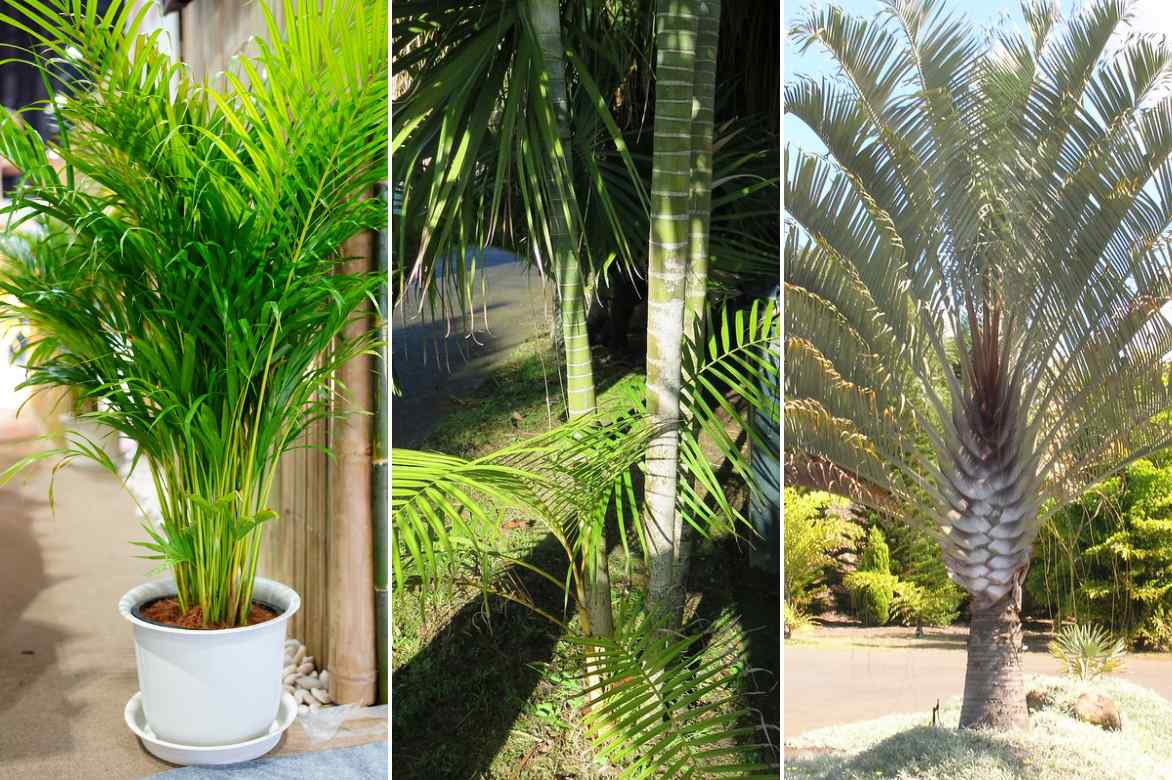
Dypsis lutescens, Dypsis baronii and Dypsis decaryi (© Forest and Kim Starr)
Dypsis is characterised by a slender and graceful silhouette, often marked by an arching or upright habit depending on the species. Its root system, fibrous and dense, extends deep to ensure good stability, although it is relatively sensitive to excess water. The “trunk” (actually a stipe), sometimes solitary as in Dypsis decaryi, sometimes multiple as in Dypsis lutescens, has a smooth or ringed surface, displaying shades ranging from green to grey, sometimes slightly waxy.
Lacking true branches, it develops directly from the base or crown a luxuriant foliage composed of long pinnate leaves, often soft and trailing, giving the plant a light and elegant appearance. Each leaf divides into fine leaflets, bright green or slightly golden depending on exposure and species.
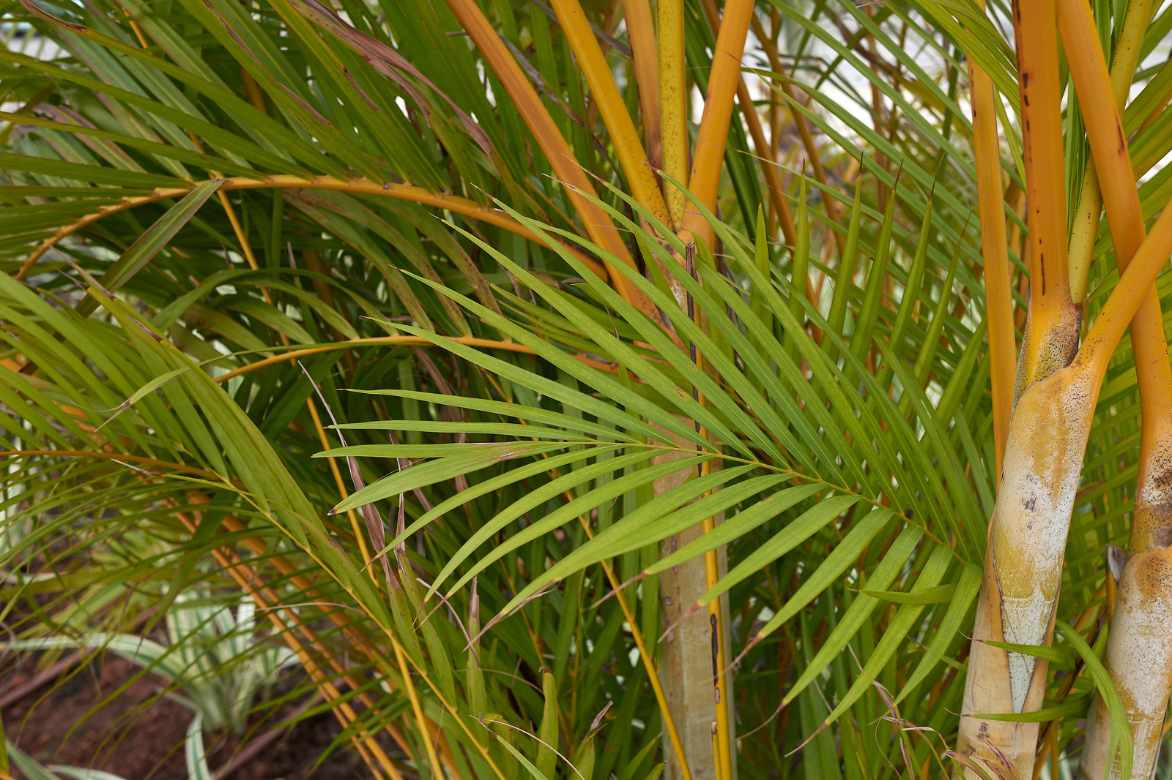
Foliage of Dypsis lutescens in its natural habitat
The flowering, discreet and rare indoors but more pronounced in the wild, takes the form of trailing inflorescences nestled in the axils of the leaves, bearing small cream or yellowish flowers. When conditions are favourable, fruiting may occur, producing small ovoid fruits, usually orange to black at ripeness, which attract local wildlife but are rarely viable in indoor cultivation.
Good to know: The Dypsis lutescens (areca palm) is recognised for its air-purifying qualities, helping to filter pollutants such as formaldehyde, xylene, and toluene from the air.
Planting Dypsis in Pots: Where, When, How?
The best time to plant a potted Dypsis is spring, when temperatures begin to warm up and the plant can benefit from active growth.
The right substrate
A Dypsis needs well-draining soil to prevent root suffocation. A mixture composed of houseplant compost, coarse sand, or perlite, and a handful of coconut fibres or pine bark is ideal for replicating its natural environment. Adding a bit of well-decomposed compost can enrich the soil, but avoid overly rich mixtures that could encourage unbalanced growth.
The ideal location
This plant thrives in bright, indirect light, such as near an east or west-facing window. A south-facing exposure can work if the light is filtered by a sheer curtain. It tolerates partial shade, but a lack of light will slow its growth and cause its foliage to etiolate. In terms of temperature, the Dypsis loves warmth: between 18 and 24°C during the day, with ambient humidity around 50 to 70% to prevent leaf tips from browning. Away from cold drafts and direct heat sources like radiators, it will thrive much better.
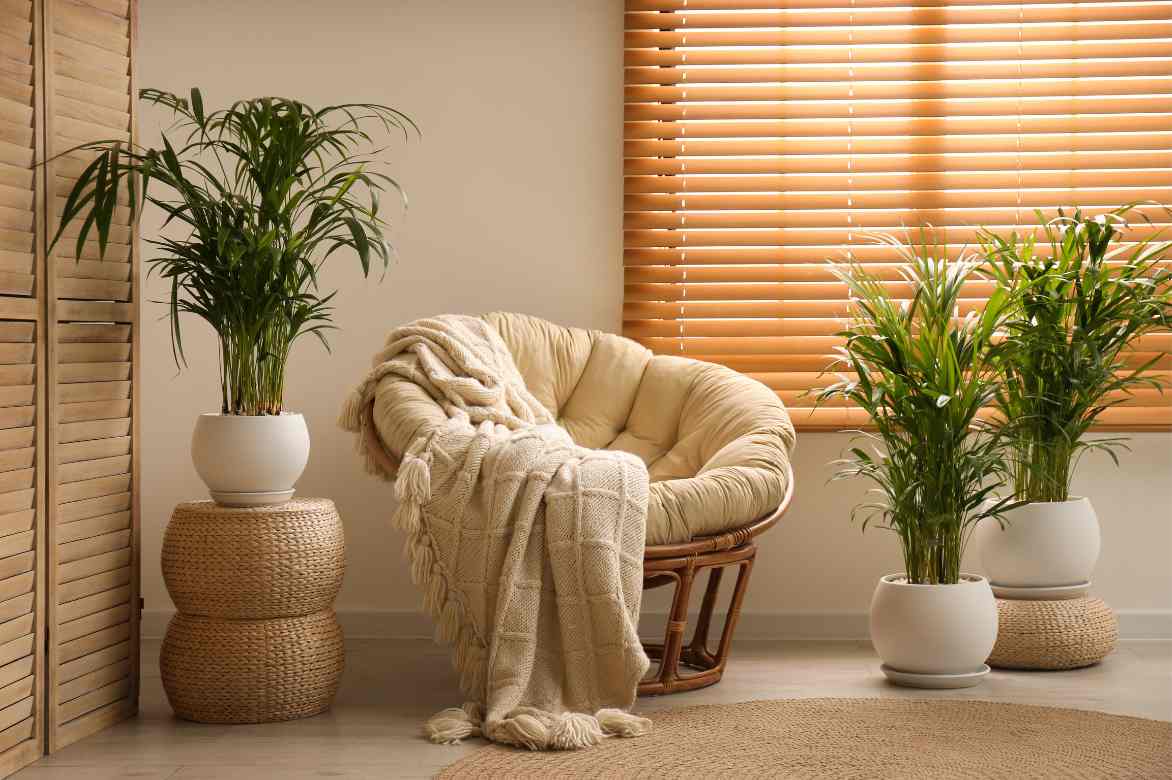
Give your Dypsis plenty of light
The right pot
The choice of pot is crucial: it must be pierced at the bottom to ensure good drainage and limit any risk of water stagnation. Terracotta pots are recommended to promote moisture evaporation, although a plastic pot can also work as long as it is well-drained. In terms of size, opt for a container 2 to 3 cm wider than the root ball, without excess, to avoid stagnant moisture.
Planting steps
- Prepare the pot by placing a drainage layer at the bottom, such as clay pebbles or gravel, about 3 to 5 cm thick.
- Partially fill the pot with the prepared substrate.
- Carefully remove the Dypsis from its pot, ensuring not to disturb its roots too much, especially if they are fragile.
- Place the root ball in the centre of the pot, adjusting the height so the base of the trunk is level with the top edge of the pot.
- Fill in with substrate, lightly tamping without compacting too much to allow air circulation.
- Water generously after planting, then wait for the substrate to dry slightly on the surface before watering again.
Repotting: when and how?
A potted Dypsis doesn’t need repotting too often, as it prefers being slightly root-bound. Repotting every 2 to 3 years is sufficient, usually in spring, when roots start emerging from the pot or growth slows down. The technique remains the same as for planting, with a slightly larger pot and fresh substrate. Between repottings, an annual top-dressing (replacing the top 3-4 cm of compost) helps maintain good nutrient levels without disturbing the plant too much.
In the ground
In the ground, the Dypsis needs light, rich, and well-draining soil, ideally a mix of garden soil, compost, and sand to avoid excess moisture. It should be planted in full sun or partial shade, sheltered from cold winds, in a climate where temperatures remain mild year-round.

Dypsis lutescens planted in the ground, in a sheltered spot
Culture and Care of Dypsis
Watering
The areca palm requires a slightly moist substrate, but never waterlogged. During the growth period, from spring to autumn, it is advisable to water approximately once a week, allowing the surface of the substrate to dry slightly between waterings. In winter, when the plant enters dormancy, the frequency should be reduced to every 10 to 15 days, or even less if the environment is cool.
The water used should be at room temperature and preferably non-calcareous, as hard water can cause whitish spots on the leaves. A tip is to let tap water sit for 24 hours before watering or to use rainwater.
Fertilisation
For vigorous foliage and a beautiful green colour, fertiliser is recommended from spring to autumn, at a rate of once every 3 to 4 weeks. A liquid fertiliser for houseplants, rich in nitrogen (N) and potassium (K), is ideal. However, excess should be avoided, as an overfed Dypsis may produce overly fragile foliage or suffer burnt roots. In winter, fertiliser is unnecessary, as the plant’s growth slows down.
Pruning and foliage maintenance
The Dypsis does not require structural pruning, but regular maintenance is important to keep it looking tidy. Dry or yellowed leaves should be cut at their base with clean and disinfected pruning shears, without touching the remaining healthy foliage. To prevent dust accumulation, which can limit photosynthesis, it is also advisable to dust the leaves regularly with a damp cloth or by giving it a lukewarm shower under the showerhead.
Precautions and points to watch
Like all palms, the Dypsis is sensitive to certain conditions that can affect its health. It is particularly important to avoid cold drafts, which can cause the leaf tips to turn brown. The dry air of heated interiors in winter can also be problematic: in this case, it is recommended to lightly mist the foliage or place the plant on a tray filled with damp clay pebbles to maintain a good level of humidity.
→ Also read Areca: maintenance throughout the seasons?

Parasites and Diseases of Dypsis: Prevention and Treatment
The Dypsis is a robust plant, but it can be susceptible to a few parasitic pests and diseases, especially if its environment is not optimal. Good prevention involves regular maintenance and careful monitoring of the foliage and roots.
The most common parasitic pests
-
Red spider mites: these tiny mites thrive in dry and warm conditions, leaving discoloured foliage and sometimes covered in fine webs. To eliminate them, it is advisable to increase ambient humidity by misting the foliage with water and, in case of severe infestation, to use a treatment based on diluted black soap.
-
Scale insects: these small insects, often visible as cottony balls (mealybugs) or small brown shields (armoured scales), attach themselves to stems and the undersides of leaves to suck the sap. Using a cotton pad soaked in 70° alcohol or a spray of black soap can help eliminate them.
Diseases and physiological disorders
-
Root rot: excess water and poor drainage are the main causes of this issue, which manifests as wilting foliage and roots turning black and soft. To save the plant, repot it in a well-draining substrate, remove damaged roots, and space out watering.
-
Brown spots on leaves: usually caused by insufficient humidity or sunburn from direct sunlight. Simply adjust watering and place the Dypsis in more filtered light to avoid the problem.
-
Yellowing leaves: a common sign of nutrient deficiency, improper watering, or overly dry air. A balanced fertiliser application and careful monitoring of substrate moisture can correct the issue.
Propagation of Dypsis: Methods and Tips
Propagating a Dypsis is not always easy, as this palm does not produce offshoots like some other species. Two main methods are possible: sowing and, in rare cases, dividing clumps for multi-trunked species like Dypsis lutescens.
Sowing: The Most Common Method
Sowing is the primary technique used to propagate a Dypsis, although germination is often slow and requires patience.
Steps for Sowing:
- Seed Collection: If you have an outdoor Dypsis that bears fruit, you can harvest its seeds. To harvest Dypsis seeds, wait until the ripe fruits turn from green to orange or black, then pick them and remove the pulp by rubbing them under water. Alternatively, you can buy fresh seeds, as their viability decreases rapidly.
- Seed Preparation: The seeds should be cleaned and soaked for 24 to 48 hours in warm water to soften the shell and stimulate germination.
- Suitable Substrate: A light and well-draining mix is ideal, such as a blend of seed compost, sand, and perlite.
- Planting: The seeds should be buried about 1 cm deep in a pot or a mini greenhouse.
- Germination Conditions: Heat is essential for germination. Maintain a constant temperature of 25 to 30°C and high humidity by covering the pot with plastic film or placing the seedlings under a greenhouse.
- Patience and Monitoring: Germination can take between one and six months, or even longer depending on the species. Keep the substrate slightly moist but never waterlogged.
Once the seedlings are sufficiently developed, they can be transplanted into individual pots and grown like mature plants.
Dividing Clumps: Only for Certain Species
For cespitose Dypsis, like Dypsis lutescens, which form multiple trunks from the base, it is sometimes possible to divide the plant. However, this technique is delicate, as the roots are often very imbricate.
Division Steps:
- Remove the Plant from the Pot carefully to avoid breaking the roots.
- Gently Separate the Offshoots, ensuring each new plant retains a good amount of roots.
- Repot Immediately the divisions in a light and well-draining substrate.
- Water Lightly and maintain moderate humidity to encourage rooting.
This method is not suitable for single-trunked species, like Dypsis decaryi, which can only be propagated by sowing.
How to showcase an Areca palm?
The Dypsis fits perfectly into bright and spacious interiors, adding a touch of exoticism and a soothing tropical atmosphere. It thrives particularly well in bohemian, Scandinavian, modern, or urban jungle settings, where its airy foliage softens lines and structures spaces.
To showcase it, a raw terracotta pot will give it a natural and authentic charm, while a wicker, rattan, or jute planter will enhance a bohemian vibe. For a more contemporary interior, a concrete, minimalist ceramic, or gold metal pot will elevate its elegant and refined look. In a minimalist or industrial space, a large black or anthracite grey fibre pot will add a chic and graphic contrast.
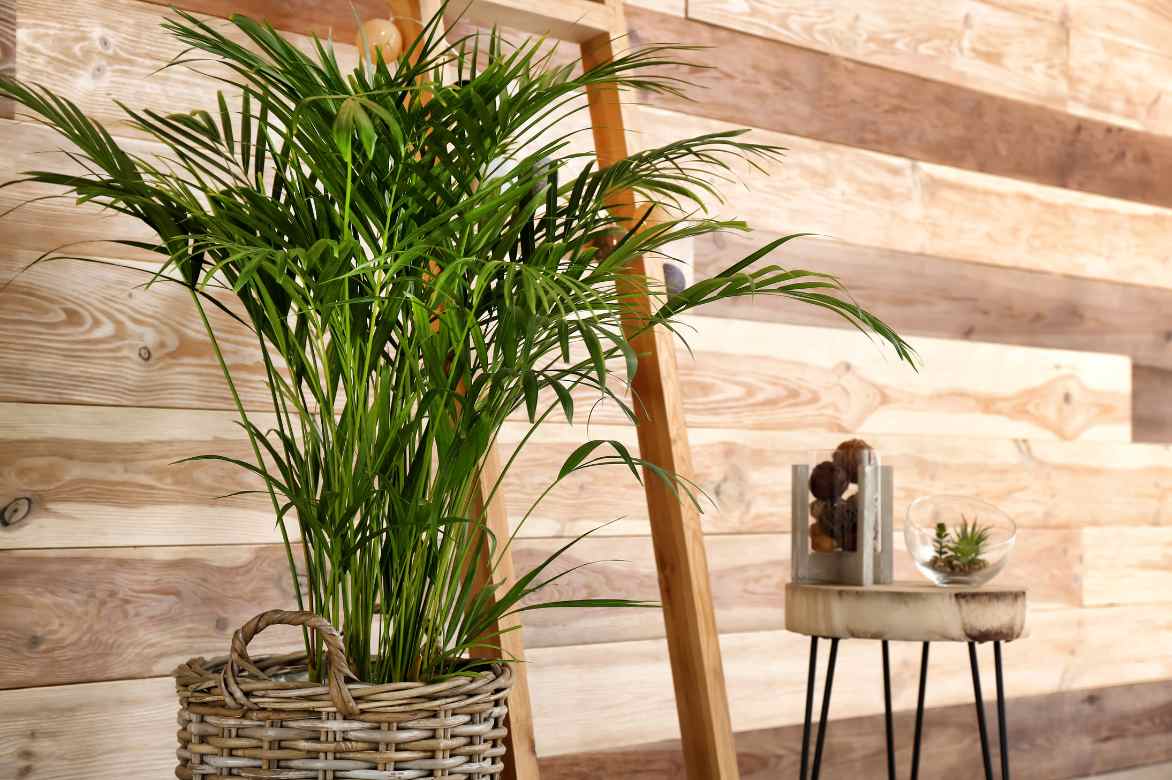
A large woven basket enhances the Dypsis!
See also...
→ Discover our wide range of houseplants.
- Subscribe!
- Contents
![Plant sheets All about the dypsis [plant_guide plant="dypsis"]](https://en.promessedefleurs.eu/blogwp/wp-content/uploads/2025/02/Pinterest-Fiches-plantes-Tout-savoir-14.jpg)































Comments